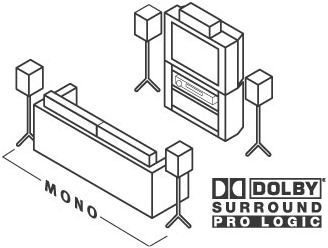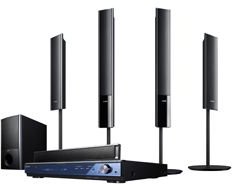Surround Sound Formats
Introduction
Stereo sound, the original 2 channel stereo, added a spatial dimension to sound reproduction. What that really meant was that, the listener was able to spatially identify the location of the instrument or the vocal playing as if he was facing the stage performance. As applied to the movies, it meant that we were able to identify the location of the speaker, on the screen rather than getting a jumble of sounds from the general area of the screen.
Ever since, sound reproduction improvements have tried to achieve this realism. A second effort has been to add the immersive dimension. If the stereo, in general, helped a listener resolve sound sources in the horizontal scale, there remained the gap in front of the listener to be covered. The surround channels that reproduce sound from the back helped add that dimension in front and from behind the listener. If the sounds you are hearing in front are supposed to reverberate from the hills at your back, the reproduced sound can recreate that feeling. Here is a set of articles on the surround sound audio formats in depth.
Speaker Arrangements
Original 2 channel stereo had a right and a left speaker. Quite often that left a “hole in the wall effect” or lack of detail in the middle. So, as a first improvement a central speaker was added. That also helped add details on the screen which were typically between the two main speakers. Two rear speakers or the surround speakers added the audio that was supposed to come from the back. That added up to the use of 5 speakers. Then a sub-woofer (aka Low frequency effects or LFE) was added to the front array that reproduced really low frequency sounds. Thus was born the 5.1 speaker system.
You also get 6.1 and 7.1 speaker arrangements. In the 6.1 arrangement you add a central speaker at the back too. In the 7.1 arrangement there are two speakers left back and right back beside the two surround speakers. In some sound formats two of the surround speakers may be driven by the same audio channel as in matrix arrangement. Discrete sound systems drive each speaker with a unique audio channel. As we get into home theaters with large screens you need to graduate to a home theater arrangement of at least 6.1 or better still 7.1. Do remember that each of these channels carry sounds that are slightly delayed from each other and reach our ears at different times. This is what simulates the delays related to sound generated at different spots on screen and sound from the back. Equipped with that knowledge, let’s look at the surround sound recording formats now.
Surround Sound Formats
Dolby surround sound was the original surround sound recording format. It was a 4 channel format. Besides driving the front three channels with unique audio channels, it drove the two rear surround speakers with the same audio. This has now evolved to many formats but they all encode at least 6 unique channels of audio. DTS (Digital Theater Sound) is the next most popular format for movie sound recording. Both have evolved through several formats over time.
Dolby Digital formats for playback include Dolby Surround/Dolby Pro Logic, Dolby Digital, Dolby Digital Live, Dolby Digital EX/ THX Surround EX and Dolby Digital Surround EX. Dolby Pro Logic II and Pro Logic IIx extend the Pro Logic capability. Dolby HD audio formats are geared towards producing sound experience appropriate to HD TV. These include Dolby TrueHD and Dolby Digital Plus. So called virtual formats that can reproduce virtual surround sound are Dolby Headphone (on headphones) and Dolby Virtual Speaker for a virtual 5.1 experience over two speakers. It works in conjunction with Dolby Digital and Dolby Pro Logic® II decoding and enhances the playback of any program material, from 5.1-channel DVDs and satellite programming to stereo music CDs and MP3 files.
Dolby Format Details

Dolby Surround/ Dolby Pro Logic uses a decoder to regenerate two coded channels of audio to create a 5.1 experience, the two back channels reproduce the same sound. Dolby digital creates the 5.1 audio experience and has become the de facto standard for DVD, HDTV, games etc. Dolby Digital Live converts any stereo or multi channel audio into true 5.1 surround sound effect in real- time. Dolby Surround Ex adds a 6th channel. This is matrixed and fed from the two Surround channels. Left and right back channels are fed by the same input in the 7.1 version. Dolby Surround EX encoding is not very popular and the DVD movies are not encoded in that format normally. The Dolby Digital Surround Ex is the same version applicable to movies.
Dolby TrueHD and Dolby Digital Plus as well as DTS HD Master audio formats deliver a very high resolution audio over 7.1 speakers to match the high resolution video available on Blu-ray discs.
DTS Has Similar Formats
DTS Digital Surround is now a close second to the Dolby format. Quite often equivalent formats from DTS provide more detailed audio resolution. Many people hence prefer these formats compared to the Dolby set. Whether in movie theaters or in home theater application DTS is able to hold its own against Dolby. Many DVD release prefer to release their products with DTS sound tracks as an alternative to Dolby.
DTS Neo:6 formats is a competitor to the Dolby Pro Logic six channel matrixed format. DTS-ES competes with the Dolby Digital EX (the home theater 6.1/7.1 version). DTS 94/26 provides a high-resolution format used in some DVD-Audio releases. In the home theater arena and this age of Blu-ray and DVDs the DTS- HD Master Audio is an exact replacement for Dolby TrueHD. DTS Virtual provides a surround sound experience on a two-channel audio system. Home theater receivers and HTIB (home theater in a box) solutions include DTS decoding as an additional facility these days.
